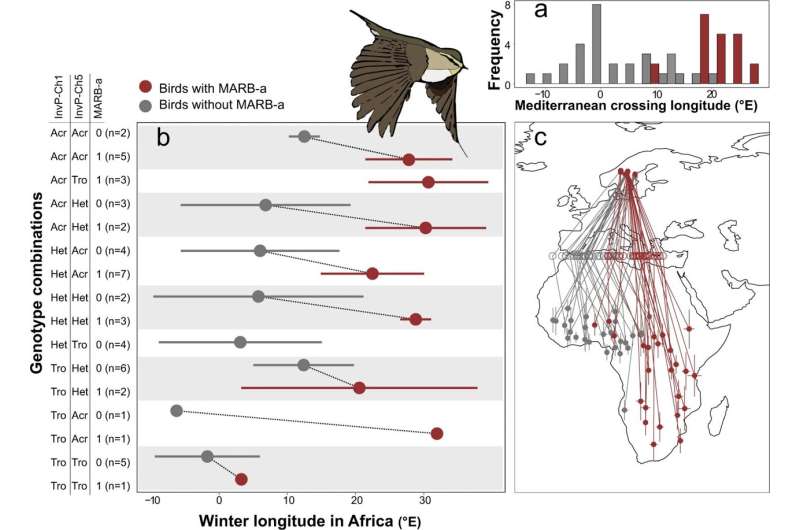This article has been reviewed according to Science X's editorial process and policies. Editors have highlighted the following attributes while ensuring the content's credibility:
fact-checked
peer-reviewed publication
trusted source
proofread
Genes decide the willow warbler's migration routes, finds study

Since antiquity, humans have been fascinated by birds' intercontinental migratory journeys. A new study from Lund University in Sweden shows that two areas in their genome decide whether a willow warbler flies across the Iberian Peninsula to western Africa, or across the Balkans to eastern and southern Africa.
Researchers have long known that the behavior that causes songbirds to migrate in a specific direction towards a remote winter location is something they are born with. The recent study aims to further understanding of the genetics behind this behavior. With the help of modern technology, and 20 years of research into the genetics of songbirds and their migration routes, the researchers managed to identify which parts of the genome that determine the songbirds' routes.
"The songbirds' direction of travel is determined by two areas in the genome. Genes from the southern subspecies take the bird towards the southwest, across the Iberian peninsula to their wintering grounds in western Africa. Genes belonging to the northern subspecies instead lead the willow warblers towards the southeast, over the Balkans, to locations in eastern and southern Africa," says Staffan Bensch, biology researcher at Lund University.
Researchers have previously assumed that interbreeding between subspecies that move in different directions would result in offspring that migrate in a direction in between these two.
For willow warblers, this would mean a route straight over the Mediterranean and the Sahara, with probable higher mortality than if they flew west or east of that route. Instead, researchers discovered that crosses between northern and southern willow warblers usually migrate like one or other of the subspecies. The price of interbreeding, then, is lower than researchers previously believed.
"Many of us struggle to find our way back to the car after a short mushroom-picking walk in the forest. That makes it almost impossible to understand how a small bird weighing less than ten grams can fly from Sweden to a specific place in Africa with no prior experience," says Staffan Bensch.
Researchers are surprised that such complex behavior as variations in migratory patterns can to such a large extent be explained by just two genetic areas.
"Knowledge of the willow warbler's behavior also helps us to understand how different species' spectacular migratory patterns have developed through evolution. Climate change means that many species are being forced to alter their routes when the habitats they are adapted to change. The more we know about the genetics of migration, the better understanding we will gain of the birds' capacity to adapt their migration patterns in response to climate change," concludes Staffan Bensch.
The study is published in the journal Nature Communications.
More information: Kristaps Sokolovskis et al, Migration direction in a songbird explained by two loci, Nature Communications (2023). DOI: 10.1038/s41467-023-35788-7
Journal information: Nature Communications
Provided by Lund University



















